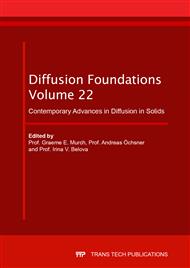p.24
p.34
p.39
p.48
p.55
p.65
p.74
p.84
p.94
Mechanical, Thermal and Electrical Characteristics of Conventionally Cast and Cold-Rolled 5754-Sc-Zr Aluminium Alloy
Abstract:
The effect of cold-rolling on mechanical, thermal, and electrical properties as well as microstructure behaviour of the Al-2.93wt.%Mg-0.34wt.%Mn-0.33wt.%Si-0.22wt.%Fe-0.19wt.%Cr-0.24wt.%Sc-0.06wt.%Zr was studied. The material was investigated during step-by-step isochronal annealing in a temperature range from room temperature up to 540 °C and during isothermal annealing at 200, 450 and 550 °C. Precipitation reactions were studied by electrical resistometry, conductivity, (micro) hardness measurements and differential scanning calorimetry. The hardening effect appears due to the additional precipitation of the Al3Sc and/or Al3(Sc,Zr) particles. The distinct changes in residual resistivity ratio above ~ 330 °C are probably caused by precipitation of the Mn (,Fe,Cr)-containing particles. This precipitation process is highly influenced by cold rolling but it has a negligible effect on hardness. The apparent activation energy values for additional formation of the Al3Sc and/or Al3(Sc,Zr) particles were determined. The kinetics of the Al3(Sc,Zr)-phase precipitation seems to be independent of Mn-and Mg-addition in the studied alloys. A partial recrystallization of the cold-rolled alloy was registered by electron backscatter diffraction after annealing at 550 °C. The initial difference in microhardness introduced by cold rolling is almost removed after annealing at 550 °C/30 min.
Info:
Periodical:
Pages:
55-64
Citation:
Online since:
May 2019
Keywords:
Price:
Сopyright:
© 2019 Trans Tech Publications Ltd. All Rights Reserved
Share:
Citation:


